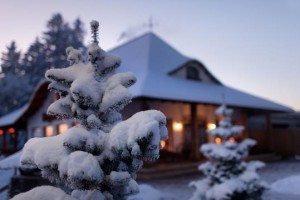
Winter is here, and you and your home need to be ready. Whether your home sees a few cold days each year or months of sub-zero temperatures with ice and snow, you can still make improvements to stay warm and protect your home from the elements. Here are five ways to prepare your home for winter.
- Seal in the Heat
Air leakage is to blame for heat loss in many homes. The warm air escapes through cracks around windows and doors, driving up your heating bills and making your home work harder to stay warm. Keep the heat in by caulking the joints between your frames and the wall, as well as all joints in the window frame itself. You may need to repeat this process over the years; check to make sure your caulk isn’t cracked or deteriorating each winter.
Some signs that your windows and doors need caulking are obvious — if you can see daylight or feel a breeze coming from your window and door frames, you obviously need to do some sealing. However, most of the time it won’t be that obvious. It’s important to regularly inspect them all for old caulking that is chipping or peeling off.
- Replace Weather Stripping
The cracks around your doors and windows aren’t the only place where they lose heat. Weather stripping inside your window and door openings can eliminate gaps that let cold air in. Applying a layer of weather stripping is a simple way to increase your home’s efficiency. But like caulk, old weather stripping can wear down and lose its effectiveness. Make sure that your doors and windows aren’t letting air in through gaps around the openings. Look for signs of wear and tear and keep a roll of weather stripping handy to use in your doors and windows.
Consider this: on a six-foot-tall door, a tiny eighth-of-an-inch gap in the doorjamb is equivalent to a nine square-inch hole. It’s easy to see how this relatively inexpensive DIY project can have a huge impact.
- Add Insulation
According to the Department of Energy, heating your home uses more energy than any other system and accounts for about 42 percent of a typical utility bill. Keep your heat inside by making sure you’re not losing it through your walls. Your walls probably already have insulation, but you can usually add more. Modern insulation is much more effective than some older forms.
You can add energy-saving insulation in multiple places in your home, such as:
- Between floor joists in an unfinished attic
- In the floor or wall separating an unheated garage from the rest of your home
- Above unheated spaces such as a basement or crawl space
The Department of Energy offers excellent resources for more information on types of insulation and how to use it to optimize your home.
- Use Heat Tape
Ice, snow, and temperatures below freezing can damage your home and freeze your pipes if you’re not careful. You can prevent damage like this by using heat tape, which is a special kind of tape that contains an electric heating element. Run heat tape along the length of a pipe to prevent it from freezing or place a strip along your gutters to keep ice from forming on cold, wet evenings.
Heat tape uses electricity, so be conscientious about how much you’re using it to avoid a spike in your electric bill. To keep usage low, use a heat tape timer so your heat tape isn’t running at all times. Be sure to turn it off completely when the weather warms up.
- Upgrade Your Doors and Windows
Upgrading to an energy-efficient door can keep your home toasty and improve your energy bills by 10 percent. Choose a metal or fiberglass door, which can be up to five times more insulating than solid wood doors.
Here’s a chilling fact: homes lose about 25 to 30 percent of their energy through windows. Keep your heat contained by installing windows with energy-efficient frames as well as insulated glass. Metal frames are the least efficient option, so if you’re shopping for new windows, choose window frames in wood, vinyl, or fiberglass. If you live in a cold climate, vinyl is your best bet. According to the Department of Energy, vinyl window frames are thermally superior to wood frames because manufacturers can fill them with insulation.
Winter can be hard on houses. Ice, snow, and even strong winds can make heating and maintaining your home difficult. One of the best ways to protect your home this year is to stay aware of how cold weather can affect it and make changes to keep the chill at bay. Keep these tips in mind for a cozy, efficient home all winter long.
Helen Chioros is a real estate expert and mom-extraordinaire with deep insight into leading healthy, family-oriented lifestyles. Currently, she resides in the Windy City with her husband and two boys (ages 12 and 8) while serving as Owners.com’s Managing Broker for Illinois. Altisource and its affiliates provide real estate services for consumers and investors.
